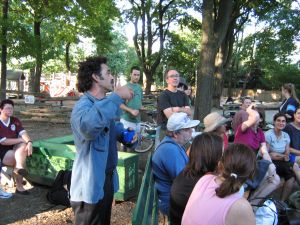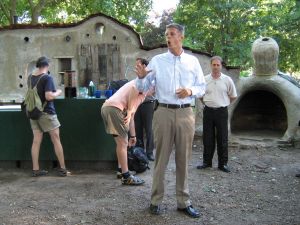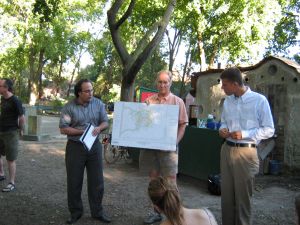Controls: show
 Document
Document
 Comments:
Comments:
[log in] or [register] to leave a comment for this document.
Go to:  all documents
all documents
Options: show
Path:
Looking inside:
 Bio-toilet
Bio-toilet
( display item 5)
display item 5)
Contact:
Website:
[home] [about] [help] [policies] [legal disclaimer]
Subsites:
 documents
documents topics
(or
topics
(or  site menu)
site menu)
 blogs
(or
blogs
(or  posts)
posts) library resources
(including
library resources
(including  pictures)
pictures) database (all)
database (all)
Members:
 Document
Document
 ·5·
Bio-toilet In Dufferin Grove Park
·5·
Bio-toilet In Dufferin Grove Park
28-May-2010 [72]
Part of
 Bio-toilet
Bio-toilet
Cob bio-toilet: There is currently no support from the City to build this structure. The plans as commissioned by the Parks branch would not allow a community-built structure, and to have it built by a contractor would be prohibitively expensive.
The $8000 never-used donated bio-toilet, however, is in storage and ready to install with a nice wooden frame structure around it. Park friends have asked Councillor Giambrone if he can help make this happen. If city councillors consider the standard price tag for a park toilet: $600,000 – and the price tag for the Exhibition Place rainwater-flush-toilet pilot project (over $900,000) – the bio-toilet seems a pretty good pilot project for public places where money is scarce but people still need a toilet.
Hopefully, conversations in the playground this spring will lead to finding a solution, for installing the long-awaited playground toilet.
Cob master-builder Georgie Donais and her family have taken on a year of being the “family-in-residence” at Kimbercote Farm, near Collingwood. From the Kimbercote website, www.kimbercote.org: “For thirty years, Kimbercote has been working with social and environmental groups, the labour movement, educators, families, grass-roots organizations and the non-profit sector. Our organizational roots date even further back to 1959, making us one of the oldest active social justice organizations in the province.” The century-old renovated farmhouse provides meeting and accommodation space for up to 125 people, and Georgie says one of their interests is increasing rural-urban links. A timely idea! Hopefully Georgie and her family will make a bridge between Dufferin Grove and Kimbercote, initially through some reports back to this newsletter.
Posted on July 4, 2006
THE ROLLER COASTER PROGRESS OF THE PLAYGROUND COMPOSTING TOILET
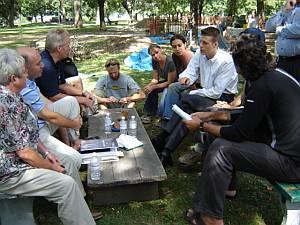
September 1 site meeting
When the big cob-courtyard-building project was going on last summer, people kept asking: so where’s the toilet going to be? For parents and caregivers of young kids, the lack of a toilet near the playground has been a drawback for years. And Georgie Donais has been interested in the ecology of sewage forever – i.e. composting toilets.
The brother of a cob volunteer, living in the southern U.S., heard about the cob project and offered to donate an industrial-strength composting toilet (the kind used in campgrounds and highway rest stops). There was no place for it in the courtyard structure, but there’s a good spot nearby, just west of the playground. In the fall, Georgie started talking to the Parks manager about the idea. She proposed building another smaller cob structure to surround the composting toilet. The manager was interested, so last February Georgie designed a beautiful, sculptural little cob building and applied for two small grants to cover its cost. Both grants – $10,000 from the Toronto Arts Council, and $2000 from the Toronto Parks and Trees Foundation – were approved.
The Parks manager has changed in the meantime, and on June 1 Georgie and several park staff met with Sandy Straw, the new Parks manager for Toronto and East York, and Peter Leiss, the new West Parks maintenance supervisor. Georgie showed them detailed drawings, specs, etc. (including the number of bums the toilet can accept before it needs a rest). But on June 7, the manager had to leave for a family emergency, and she didn’t get back until June 26. The supervisor was also busy or away for that whole time, and suddenly the whole project was in trouble because the permissions were not ready.
Georgie wrote: “I am getting more and more concerned that building season is passing us by; volunteers are now in the park, and we are missing the chance to make use of their skills.”
On June 29, we went into crisis mode and talked to everybody including City Councillor Adam Giambrone, about the possibility that Georgie might have to give back her funding if the project couldn’t get going. Lucky for us, we were able to get the attention of all those busy management people, and the project is going ahead after all. The foundation will hopefully be done by the middle of July, and then: let the cobbing begin! To find out more, go to Georgie’s web pages: dufferinpark.ca/cobcourtyard, or read the park bulletin boards. Georgie can be reached at cob@dufferinpark.ca.
BIO-TOILET IN THE PARK
Bio-Toilet Project
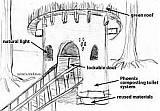
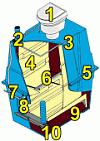
Last September, the City Parks management hired architect Martin Liefhebber to evaluate the plans for the community-built bio-toilet shelter. Because the shelter is less than 100 square feet, park friends believed that it would be exempt from needing a building permit. That’s what the building code says for small structures. But it turned out that the code gets more complicated when a toilet is involved. In this case the structure houses a National Parks-style bio-toilet model, composting waste instead of being hooked up to the sewer grid. The shelter is built of cob (clay, sand, straw and water, mixed with bare feet) by ordinary people including kids. That’s right outside the standard rule book, so it produces a regulatory headache.
The City asked the architect to help get building code approval for this structure, which is based on elements built and approved elsewhere in Canada, but not common in Toronto. They made good progress, working with the building inspectors, but there was one big problem from the point of view of the park cob builders – the conversations, planning, and drawing up of blueprints was done without any involvement of Georgie Donais after the initial consult. The City Parks management didn’t invite her into the discussions nor was she even told when there were meetings. When she was shown the finished plans in April, she saw that some small but important building issues had not been addressed.
Georgie has now been brought into the conversation. The working parts of the composting toilet have been accepted by Toronto Buildings, and the City has hired engineer Kharyn Chau to go over the plans for the cob housing from an engineering standpoint. Buildings like this, some of them many hundreds of years old, exist all over Britain, Europe and the Middle East. If they can be made to fit the code in Ontario, Toronto will be one of the first cities in North America to have stamped, approved plans for such an environmentally-friendly amenity – in the forefront again!
INFORMATION SESSION ABOUT THE PLAYGROUND BIO-TOILET:
Friday July 13, 2007, 7 pm by the playground.
Info-Session #1 Bio-toilet
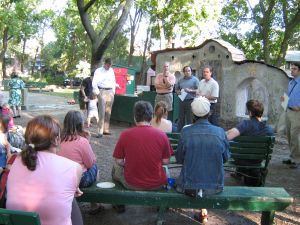
Councillor Adam Giambrone, Capital Projects Manager: Peter Didiano, Parks Supervisor: Peter Leiss
The playground’s cob courtyard (its thick walls made with “cob” – i.e. clay, sand, straw, and water mixed together – a bit like adobe) was originally built to frame the public-health sinks for the wading pool snack bar. During the summer of 2005, about five hundred people participated with park user and builder Georgie Donais to shape that little courtyard, and it ended up having more than sinks -- a fireplace and a green roof and even a baby changing station. But one element was still missing: a toilet handy to the playground. Playground users have been asking for such a facility for many years, but there was never enough money – building a new park washroom costs around $100,000. What to do?
When a park visitor told of his good experiences with the new industrial-strength composting toilets in the U.S., and then even offered to donate one (value: $8000), it seemed like the problem of the missing toilet could be solved.
Georgie researched the kind of toilets that are commonly used where location and circumstances prohibit standard plumbing hook-up, and found a brand of composting toilet that held promise. She visited such installations, made phone calls all over the country, consulted with the park managers, and applied for a grant to help build a simple cob shelter around a “Phoenix” brand composting bio-toilet. The plans called for bas-relief sculptures all around the shelter’s walls, and the Toronto Arts Council approved a $10,000 “Community Arts” grant.
Work began in the summer of 2005. But then concern among some park neighbours that the toilet would be more like a smelly chemical toilet than an ecological break-through, put the project on pause. The Parks Department, interested in the possibilities of such toilets for parks which haven’t got the plumbing infrastructure, hired Martin Liefhebber, an architect well-known for his green credentials. The City followed up by hiring an engineer too, who could help the small cob toilet housing meet the building code. The building code does not specifically address earthen building processes, so the engineer has had to work hard. Now the engineer and the architect, consulting with Georgie, have almost finished adapting the building to the regulations. City Councillor Adam Giambrone says it’s time to hold an information meeting to show how the playground toilet can be constructed, in all its details. But the steel supports they recommend for the cob housing will increase the cost of the toilet by an yet-unknown amount, perhaps many thousands of dollars.
All the building details – architectural drawings, CSA-approved bio-toilet standards, sketches of the sculptural elements of the building walls – will be posted at the wading pool shed in the week of the meeting. For those people who live near the park but don’t come there to look at the bulletin boards, notices and this newsletter will be delivered to their houses well in advance of the meeting. The meeting should be a fascinating encounter between different views of how parks can serve their neighbourhoods, even at a time when there’s little available public funding for improvements. Meantime, the City of Edmonton has commissioned a bank of Phoenix bio-toilets for its downtown, and a similar model is reportedly servicing the busiest zoo in Japan. Is it Toronto’s time to try this solution, or not yet? Do park friends have the resolve to raise all the extra money the building code adaptations require? Can Parks management find the time to give the institutional support needed? Will the final plans win over the park neighbours worried about malfunction? Come to the information session after Friday Night Supper and share your thoughts.
THE BIO-TOILET: EDITORIAL

Artist's conception of the Dufferin Park Bio-toilet
Bio-toilets (modern composting toilets), of the sort that Georgie Donais got donated for Dufferin Grove Park, have passionate friends – and passionate enemies too, such as the park neighbour who wrote in her blog recently that she had worked hard to bring in “enough building inspectors to delay the shithole for 2 years.”
Despite that kind of opposition, new bio-toilet projects seem get written up in the papers every few weeks now. Since Georgie Donais began the project at Dufferin Grove, a bio-toilet was put in at the Markham Fairgrounds, where there can be 100,000 people visiting a weekend event. The Toronto and Region Conservation Authority has put in a bio-toilet staff washroom for 45 people at their offices in Vaughn. Their resource project manager Dave Rogalsky said "Using technology such as the compost toilet is a matter of changing people's perceptions. The idea of it can give people the creeps. But we’re committed to sustainability and our site was 400 metres from city services, so compost toilets were an easy sell.” They figured out that the bio-toilets reduced their water usage by six times the norm.
The City of Edmonton parks system has put in bio-toilets that will be up and running by next summer. The Bronx Zoo in New York City has “eco-restrooms” designed to accommodate more than a half-million visitors per year, with 14 foam-flush bio-toilets and four waterless urinals. The Mountain Equipment Co-op in Winnipeg has bio-toilets, and so does the CK Choi Institute of Asian Research at UBC in Vancouver. They figure that their five units save nearly 100,000 gallons of water per year.
Meantime it seems pretty clear by now that Parks management is not much interested in supporting the Dufferin Grove bio-toilet project. Georgie Donais was only occasionally allowed to be at the table when the plans were drawn up by the architect hired by the city (an architect for a toilet is unusual, but that’s what the inspectors required, after the project’s opponents alerted them). Since Georgie was not allowed to be a full participant in the planning, the building permit that came through has some serious problems. But the foundation plans are fine, and that part might have been started in September. It seemed like the City’s own workers might take on the foundation contract, since it mainly involved pouring cement, something at which the city’s Technical Services are very experienced. However, Georgie was not allowed to talk to them directly – everything had to go through Parks supervisor Peter Leiss. After three months of keeping her waiting, Mr.Leiss finally let Georgie know that Technical Services wouldn’t do it. And so on it goes, with blocks and inaction in every direction. .
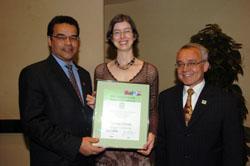
Georgie has written to Mr.Leiss that she can’t continue to work on this basis: “It is clear to me that we continue to have two very different ideas about what kind of cooperation and collaboration it is going to take to get this project successfully completed….It is time for the city to stand behind its stated commitments both to water conservation and to community collaboration.”
It may be that the issue will need discussion at the Parks and Environment Committee, to see whether environmentally-minded councillors can direct Parks management to stop dragging their feet.
The city’s commitments to water conservation are firm, but sometimes hard to see in action. Certainly the drought this past summer and fall was a warning, but conserving water during that time by not watering the newly planted trees seems like it was a bad idea. Better to try an ingenious little waterless technology that can be built and installed with hands-on help from park users, and that can add fertility to the park instead of sending more sewage to the lake.
 previous display previous display |
next display

|
 home
home
 about
about

 return to container details page
return to container details page


